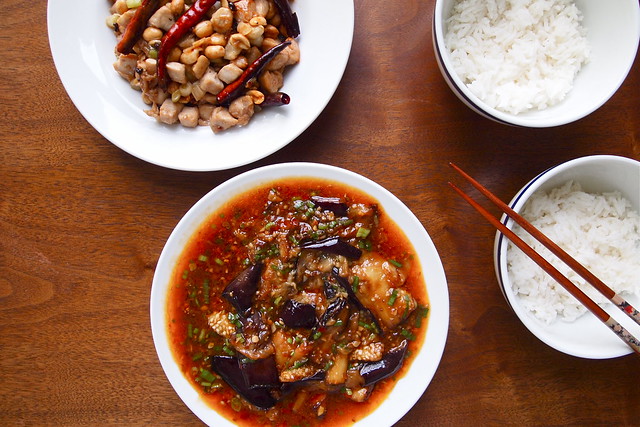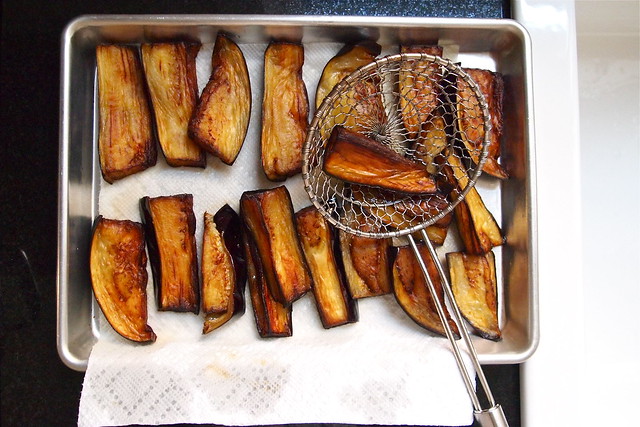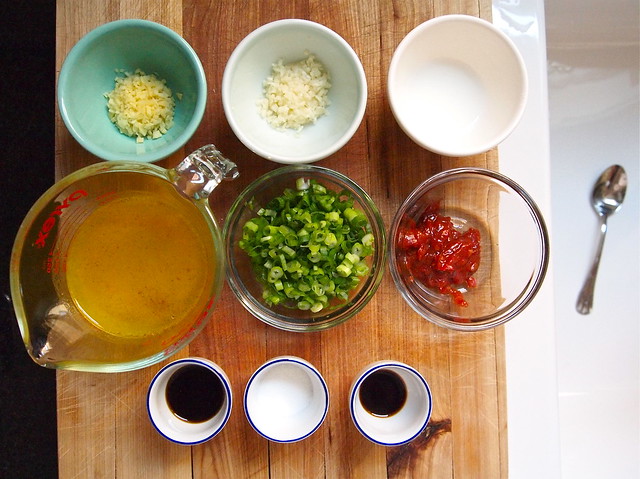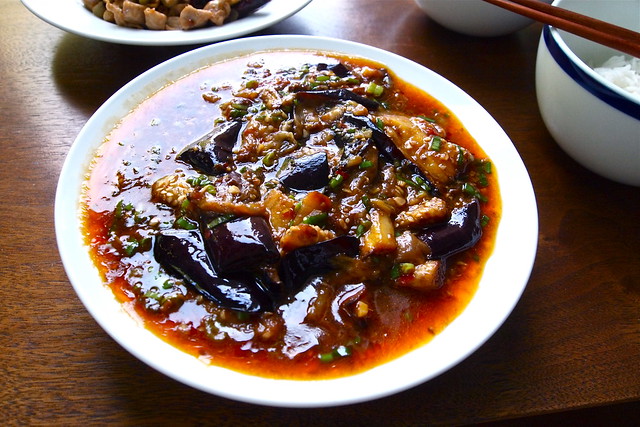Exciting news! Today, a couple of other home cooks and I will be video-chatting live with Fuchsia Dunlop as a part of this month's New York Times' Recipe Lab. Dunlop is an expert on a number of China's regional cuisines and author of a fantastic travel memoir and three cookbooks, including Every Grain of Rice. We'll be talking with her about Chinese cooking and a dish from EGR we all made, Gong Bao Chicken. Tune in to Recipe Lab at 3 pm Eastern. It's going to be great! If you're a bit confused about why I'm participating in this chat (when, after all, was the last time that you saw anything Chinese around here?), see below for some background.
Cultural identity can be a funny thing. My mother is Cantonese. I grew up crunching my way through bok choy slicked in oyster sauce, wrinkling my nose at bitter melon, sneaking bits of crispy pork skin when I didn't think anyone was looking. But you wouldn't know it from the way that I cook and eat now, at least not in a way that I can see. Sure, I'm not half-bad at picking clean a small pile of spicy chicken feet, and I can appreciate the gelatinousness of vinegar-braised pork hocks. But I couldn't tell you much about the ingredients and methods. In fact, I don't really know how to cook any of the food I ate growing up. I just wasn't all that interested in learning to back then, and this part of my heritage is something I've always had a bit of a hard time with. I still don't really know how it fits in with who I am.
But lately, I've been trying to get a better handle on Chinese cooking (which is not to say that there's really one thing you could call that). See, at some point next year, I'm going to be travelling with my mother in China for a few weeks. This won't be the first time that I've visited, but I feel as though I've done quite a bit of growing up since my last couple of trips, and I want this one to be different. On past trips, I've left most of the planning up to my mother and her sister, and while we've seen some really amazing things together, the food, at least when travelling outside of Guandong, the province my family is from, has never been particularly good. But this, I'm pretty sure, has only been because we've relied on packaged tours when far away from Guandong. The meals are pre-arranged and totally unremarkable. My mother would probably argue that this is convenient, that it leaves us with time to see and do more, but I of course think that stumbling on a good place to eat just is a part of the seeing and doing. So this time around, I've decided to take charge, and the first step has just been learning more about some of the regional cuisines.
My starting place has been Fuchsia Dunlop's memoir, Shark's Fin and Sichuan Pepper. Dunlop, though British, has spent a great deal of time in China since her early twenties. She was in Chengdu (the capital of Sichuan province) initially with a year-long British Council research grant and was supposed to be studying the government's policy on ethnic minorities. But when that didn't go very far (people, unsurprisingly, were reluctant to talk), she found herself drawn to the activity in Sichuanese kitchens and to the often strange but splendid food that came out of them. She talked to everyone she could about Sichuanese food, begged her way into restaurant kitchens to observe and take notes, and eventually trained as a chef at the Sichuan Institute of Higher Cuisine, the first Westerner ever to have done so. She had found her calling.
The memoir details Dunlop's experiences in China over the years. It's a compelling blend of sharp observation, personal narrative, and reflection on the cultural differences she has run up against. And food, unsurprisingly, is often at the centre of all this. Dunlop, for example, is struck one evening by how much her time in China has changed her appreciation of texture when she realizes that her parents are politely struggling with the items she's ordered for their hotpot--goose intestines, ox tripe and throat cartilage, rabbits' ears, and small bony catfish, all unpleasantly rubbery, squeaky, crunchy things in the average Westerner's mouth. But for her now, there's a distinct pleasure to these textures. Chinese gastronomy isn't just about flavour but the subtle play of temperature and texture. It takes time, experience, and a lot of polite crunching, to really appreciate this (which is not to say, of course, that all Chinese food is this challenging). Dunlop often connects coming to eat like the Chinese with coming to think like them too, and there definitely is truth to this. It's what, I think, makes her memoir so illuminating when it comes to Chinese culture and what has led me to the kitchen in preparation for this trip.
A couple of weeks ago, with all these thoughts about identity, food, and travel were simmering away in my head, I noticed that Fuchsia Dunlop was the cookbook author who was going to be featured in the New York Times' Recipe Lab this month. Recipe Lab is the Times' monthly feature in which readers are invited to cook a recipe from one of the featured author's books and a few home cooks take part in a live video chat with the author. Seeing this, I applied to participate in the chat and thought that I probably wouldn't hear back. But I did! And it's happening today! So, tune in live to Recipe Lab to see me and a couple of other home cooks chatting with Ms. Dunlop about Chinese cooking today at 3 pm Eastern.
For the video chat, we all cooked the Gong Bao (a.k.a. Kung Pao) Chicken from Dunlop's latest cookbook, Every Grain of Rice. (The cookbook, by the way, is gorgeous. I've been pouring over it obsessively.) If you want to hear more about that, you'll have to tune in today (or stream it later at your convenience). But the day I made the chicken, I was feeling ambitious, so I also made another of Dunlop's dishes to go along with it, Fish-Fragrant Eggplant. This eggplant is crazy good. I'm already planning on making it again later this week. It isn't the quickest dish to put together, but it's worth your time. You first fry slices of eggplant to a gleaming gold. Then, you sizzle Sichuanese chilli bean paste (a savoury paste made from fermented fava beans) in hot oil and add to that lots of minced garlic and ginger. This forms the fragrant base for the sauce into which you'll slip the eggplant. Stock, soy sauce, and a little sugar come next, then the eggplant, followed by cornstarch to add some body to the sauce, and Chinkiang vinegar (a dark, heady rice vinegar) and chopped scallions to finish. (There's no fish in this dish. Fish-fragrant refers to the seasonings in the sauce, which are traditionally used for fish in Sichuanese cooking.) The resulting dish is incredible. The eggplant has a silky, luxurious feel to it in your mouth, and the sauce is somehow tangy, bright, and deeply savoury all at once.
I still haven't attempted anything like the dishes I grew up with. Sichuanese cooking is spicier, punchier, than the cooking you find in Guandong. But I think I might just wait until the next time I see my mother for that. I'll ask her to show me what she does (finally), and I'll cook this eggplant for her.
Fish-Fragrant Eggplant
From Fuchsia Dunlop's Shark's Fin and Sichuan Pepper (reprinted in Every Grain of Rice)
NOTE: Dunlop says that you can also bake or shallow-fry the eggplant for this dish. But instead of then adding the eggplant to the sauce, she recommends that you pour the finished sauce onto the eggplant--otherwise, it might disintegrate. I chose to deep-fry. However, I used a heavy-bottomed 4-quart stock pot instead of a wok for both the deep-frying and the sauce. I also used homemade vegetable stock instead of chicken stock, just because it was what I had around. You should be able to find Chinkiang vinegar and Sichuanese chilli bean paste at your local Chinese grocery store. Lee Kum Kee is a common brand that sells the latter. As Dunlop says, the brand is Cantonese and their version of the paste has some ingredients you wouldn't find in a traditional Sichuanese paste. Pixian brand is a better choice, but Lee Kum Kee will do.
TO FRY THE EGGPLANT
600-700 g eggplant
Salt
Peanut oil for deep-frying
FOR THE SAUCE
1 1/2 tablespoons Sichuanese chilli paste (dou ban jiang)
1 tablespoon finely chopped fresh ginger
1 tablespoon chopped garlic
2/3 cup chicken stock
1 1/2 teaspoons sugar
1/2 teaspoon light soy sauce or tamari
3/4 teaspoon cornstarch, mixed with 1 tablespoon cold water
1 1/2 teaspoons Chinkiang vinegar
4 scallions, green parts only, sliced into fine rings
1 teaspoon sesame oil
Cut the eggplant in half lengthwise and then crosswise. Chop each quarter lengthwise into three or four evenly sized chunks. Sprinkle generously with salt and leave for at least 30 minutes to drain.
In a wok, the oil for deep-frying to 356-392 degrees F. Add the eggplant in batches and deep-fry for 3-4 minutes until lightly golden on the outside and soft and buttery within. Remove and drain on paper towel.
Drain off the deep-frying oil, rinse the wok if necessary, and then return it to a medium flame with 2-3 tablespoons of oil. Add the chilli bean paste and stir-fry until the oil is red and fragrant, then add the ginger and garlic and continue to stir-fry for another 20-30 seconds, until they too are fragrant.
Add the stock, sugar, and soy sauce and mix well. Season with salt to taste, if necessary.
Add the fried eggplant to the sauce, bring to a boil, then let let them simmer gently for a few minutes to absorb some of the flavours. Then sprinkle the cornstarch mixture over the eggplant and stir in gently to thicken the sauce. Next, stir in the vinegar and spring onions and leave for a few seconds until the onions have lost their rawness. Finally, remove the pan from heat, stir in the sesame oil and serve.





I'm excited to hear/see the chat! I've loved Fuchsia's writing since I first discovered her and I own every single one of her books, though I've never actually cooked from one yet. YET. Loved reading about your heritage and can't wait for your trip - I think it'll be fascinating to see what you end up "seeing" this time around.
ReplyDeleteYou should definitely cook from her books! I don't know how easy it'll be to find some of the ingredients in Berlin, but once you have the basics - chiles, Sichuan pepper, Chinkiang vinegar, Shaoxing wine, Sichuan chile bean paste, and maybe fermented black beans too - most of her recipes should be open to you.
DeleteAs for the trip, there aren't any dates set yet, but my mother and I will probably be doing a lot of planning over the winter break together.
Hi Katie,
ReplyDeleteHow exciting; I'll be sure to tune in! I love Fuchsia's books and the memoir; Chinese cooking was actually one of the first things I undertook when I got into cooking in the early years of graduate school. It's funny how, even though I still return to her recipes every now and then, I don't do as much Chinese cooking anymore...Although I was telling the Greek only this morning that there was a pork recipe of Dunlop's that I've been wanting to make again (this is my attempt at menu planning for the week; we'll see how this goes!).
By the way, the eggplant sounds amazing. Perhaps I should make it as a vegetable side to accompany the pork? Thanks for the inspiration and looking forward to more of your Chinese cooking adventures!
I'm not sure how much Chinese cooking I'm going to end up doing day-to-day. I'm still trying to figure out the rhythm of it. I'm not used to cooking two or three things at a time on a week night. And with school starting again, we'll just have to see!
DeleteWhich pork recipe is it? I'm excited to try more meat dishes from the book.
I can see the eggplant complementing a pork dish well. You might still want to make something leafy and green too, though, just for contrast.
Hi again, Katie,
DeleteI'm with you on the figuring out the rhythm of Chinese cooking front! Last week I ended up making bok choy, zucchini with garlic (a keeper for sure; so simple, but amazingly delicious. This dish alone demonstrates the transformative power of peanut oil and heat) and Peng's Home-style Bean Curd, which is the pork dish I had mentioned to you. It was quite an endeavor, but a worthwhile one since it resulted in a feast!
As for the recipe, I'm not sure that it's in Every Grain of Rice (it's in the Revolutionary Chinese Cookbook), but you can find it in Fuchsia's old columns for the Guardian. That's where I first learned about it back in 2008.
I never heard about Fuchsia Unlop before, but now I am looking forward to the chat and reading some of her writing. Sounds like a really interesting and wonderful life. And this eggplant dish sounds dreamworthy. I love going for an ingredient scavenger hunt, right now I am not sure whether I can find the paste or the vinegar here, but that is part of the fun!
ReplyDeleteAnd like Luisa, I cant wait to read about your trip.
She is a really, really great writer. She does an amazing job of conveying the deliciousness of certain foods the likes of which the reader has probably never seen before. It is easy to get drawn in.
DeleteGood luck with your ingredients hunt, Lena! (I assume that you're back from your travels?)
Lena, Dunlop wrote up a follow-up post on her blog about ingredients substitutions: http://www.fuchsiadunlop.com/new-york-times-recipe-lab-a-note-on-substitutions/. I hope you find it helpful!
DeleteKatie, thanks for your help. I actually found the vinegar and the chili bean paste in a local Chinese store. And I actually ordered Every Grain of Rice and should get it today or tomorrow. I already cooked her vegetarian ma po doufu and am excited to try something new.
DeleteGlad to hear it! I haven't tried the ma po dou fu yet, but it is on my list. I'm just waiting for some fermented black beans to arrive in the mail.
DeleteI made it without the fermented black beans since I have yet to find them here. Maybe they actually have them in the store I already went to, maybe I should just ask (but then I turn shy and prefer to just look myself)
DeleteI'll go check out the stream now, since I missed it live. Super cool you took part! I read Fuchsia's memoir many years ago, and the same passage stayed with me -- her growing appreciation for "mouth-feel." I probably remembered it because it was so foreign to me. Those textures, I fear, do not appeal to my untrained mouth.
ReplyDeleteThis is an intriguing recipe, especially because I've been getting a ton of eggplant in the farm share lately. The key will be collecting all the ingredients first!
(PS I forgot to mention we ended up eating at one of your restaurant recommendations - the publican - it was fun!)
Just watched it. My - Fuchsia is brilliant! What an endless knowledge of chinese cuisine. Your questions were great too!
DeleteAh, glad you liked the Publican. It rarely disappoints!
DeleteKatie what a thoughtful romp through some of your musings about identity and cooking and the interplay between them. And what a recipe! I've been intrigued by Fuchsia's cookbooks for a long while, I read her memoir and loved it but just haven't made that leap -- looks like now I have even more reason to get started. In the meantime, I look forward to someday reading about the recipes you learn from your mother. Happy travel planning to you both --
ReplyDeleteHannah, thank you.
DeleteI can't really put my finger on why this is, but it does seem harder to make the leap here than elsewhere. Is it that you need a wok, that you need to poke around Chinese grocery stores, shelves filled with items with not much English labelling? I don't know, but it's a leap worth making.